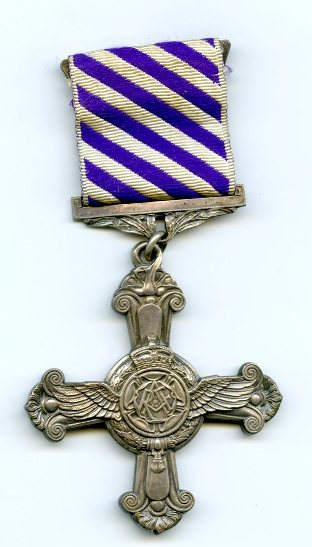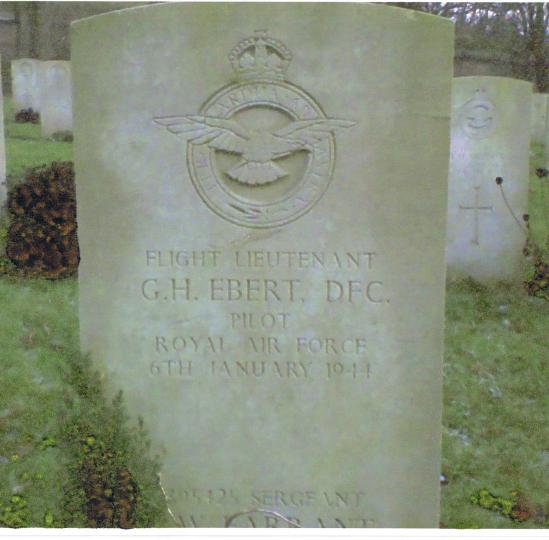| Roll of Honour | |||
|
George H. Ebert DFC |
|||
|
'Harry' was their
oldest son. They had five other children: 'Harry' joined the Royal Air Force in 1934, qualifying in fighters and bombers. 'Harry' married Christina Nelson Parker in April 1939. Christina was from Hucknall near Nottingham. RAF Hucknall was where 'Harry' was stationed in 1937, as a Sergeant pilot with 98 (Bomber) Squadron. In April of 1939 RAF Hucknall became the home of No.1 Group, Bomber Command Headquarters.
On 10th May 1940 the attack by Germany on
the Low Countries and France commenced. The RAF was called upon to try and
stem the advance and in the next four days the Fairey Battle squadrons took
heavy losses typically 50% was a reasonable expectation for planes
returning. The Fairey Battle had a three man crew, it had the same single
engine as a Hurricane fighter but carried a 4x250lb bomb load. The German
main fighter the Me 109 - was about 100mph faster. The Battle was also
vulnerable to ground fire. Having flown Fairey Battle light bombers with 142 Squadron during the battle for France, 'Harry' served as an instructor at 24 air School in Dunnottar, South Africa, and by 1943 he was serving as a Flying Officer with 207 Squadron flying Lancaster Bombers. The following Combat Report is held at the National Archive:
Aircraft: ED 832 X Lancaster III Night: 12/13.6.1943 On the night of 12/13 June 1943, Lancaster X of No. 207 Squadron was detailed to attack Bochum. At 0137 hours, 10 -15 miles S.E. (south east) of Bochum, flying at 22000 feet, on a magnetic course of 144o, with an I.A.S. (indicated air speed) of 180 m.p.h. the front gunner sighted a ME. 110 on the port box, below, at 100 yards, flying on an opposite course. The e/a (enemy aircraft) passed to the starboard quarter and came round dead astern at 600 yards and broke away. There was no fire from either aircraft. At 0141 hours, , the Lancaster was heading 192o, with an I.A.S. of 180 m.p.h. when the e/a, probably the same one, came in from astern, 1000 above, firing from 200 yards, until breaking away at 100 yards on the starboard beam down. The Lancaster returned fire immediately. For both attacks the visibility was good with the moon well up. The was no ground co-operation. Barrel corkscrew defensive action was taken each time and the Lancaster was undamaged. No claims of damage to the e/a are made. The M.U. (mid-upper) Gunner fired 40 rounds.
Rear Gunner Sgt Simmons No.4 A.G.S. (air gunnery school) and 16
O.T.U. (operational training unit) |

presented by |
||
|
'Harry' and Christina had one child a daughter Lesley Elizabeth Ebert who was born on 28th November 1943. 'Harry' died on 7th January 1944, and is buried at the Poznan Old Garrison Cemetery. Taking the place of another pilot who was unfit to fly George Ebert was at the controls of Avro Lancaster ED586 EM-F. The aircraft took off from RAF Spilsby in Lincolnshire just minutes before midnight on 6th January 1944. The aircraft was shot down in the target area of Stettin, which at that time was in Germany, and is now part of Poland. George Ebert had logged 23 operational sorties. It was in this aircraft 'F for Freddie' that Wynford Vaughan Thomas did a trip to Berlin on 3 Sep 1943 to make the famous BBC recording, broadcast by the Home Service on 4th September 1943 of a Lancaster crew on a bombing raid. |
|||
|
|
|||
|
The Crew on the night of 6th and 7th January 1944: Pilot - Flight Lieutenant George Henry Ebert DFC RAF |
|||
|
The Essex Chronicle of Friday January 14, 1944 in it's "An Essex Man's Diary" opened with: Missing after Stettin Flight-Lieut. Ebert joined the R.A.F. as a sergeant-pilot in 1935. Thus he served throughout the fighting in France as a pilot of Fairey Battles. He was officially listed wounded in action. After Dunkirk he helped bomb the "invasion ports." Then came a turn as an instructor in South Africa. On returning to England he piloted a Lancaster. He had only one more operational flight to make to complete his present tour of operations. His last flight was his 29th. Flight-Lieut. Ebert is married, and has one daughter. She is only five weeks old. His father, P.T. instructor at Felsted School, and his mother, are at Ross-on-Wye with the School. |
|
||
|
|||

%20and%20Wynford%20Vaughan%20Thomas%20(right).jpg)

